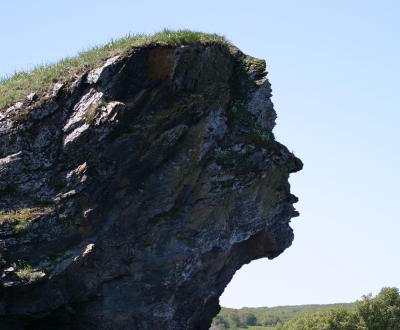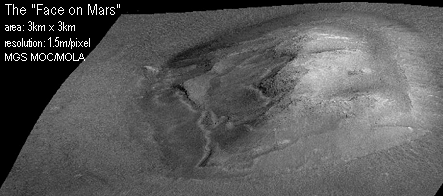What I call "Face Rock",
57° 23.959' North, 153° 50.904' West,
West shore of Uyak Inlet, Kodiak Island.
This page tells a rather interesting story, mostly about human gullibility and a preference for magical thinking over reason. First, please look at the picture called "Face Rock". It is a photograph I took this season from my kayak, while paddling in Uyak Inlet on the West side of Kodiak Island. It is unchanged in any way — I simply pressed the shutter button, then put the result on this page — nothing else. The rock looks exactly like the picture.
I was amazed when I first saw the rock, and because of where I was paddling, I seriously doubt anyone else has noticed this view of this rock: you have to see it from a particular angle, it must be from the water side of shore, the water is too shallow for most boats and too cold for swimming. It is just possible that no one has happened by in a shallow-water boat like a kayak to get the specific view I saw and photographed.
But, remarkable as it is, this is just an example of something common in nature — things we see and interpret as faces, or animals, familiar shapes in rocks, branches of trees, and so forth. It relies on our tendency to interpret random shapes in familiar ways.
But that is by no means the end of the story. People who don't know how to think tend to assume that, if a face shows up in a rock, it cannot be natural, it must be the work of aliens, or whatever.
For example, in 1976 NASA's Viking 1 Mars Lander spacecraft (a project that I played a small part in) took a photograph of the surface of the Cydonia region of Mars that was to become rather controversial over the years. In the poor resolution available to Viking's camera, it appears to show a human face on the surface of Mars (see below).
This photograph quickly attracted the attention of those intellectually challenged individuals who look at clouds and see alien spacecraft. Pretty quickly, with the eager assistance of late-night radio talk-show hosts, it was portrayed as a NASA conspiracy to conceal from the public this clear evidence of an alien civilization (no one seems to wonder why NASA would want to do that).
NASA could not fail to notice the stir this photograph caused, and, not wishing to mislead the public, resolved to get better pictures as soon as possible. This opportunity came in 1997, when Mars Global Surveyor, a spacecraft with a much better camera, was placed in orbit around Mars. As the photos below show, the clearer the picture, the less evidence there is for a face.
(left) Original Viking Photo
(middle) Mars Global Surveyor 1998
(right) Mars Global Surveyor 2001
You might think this clear photographic evidence would dispel the notion that there is proof of an alien civilization on the surface of Mars. Oh, please, think again. There are people who must believe this sort of thing — evidence is an obstacle to fervent belief. In fact, it seems any evidence NASA offers from now on only serves to confirm the assumption of a grand conspiracy. In the uniquely wacko reasoning of the Cydoniaphiles, if NASA does nothing, it's a cover-up, and if NASA offers more evidence, it's a conspiracy.
So, for what it's worth, here's my contribution to this celestial mulligan stew. Look at my picture above — it is a much better example of a face in a rock than Cydonia is. In fact, unlike the "face on Mars," you can go there and see it for yourself, confirm that it is not sculpted by anything but wind and rain.
Which obviously leads to the second issue. If there is a face so clearly sculpted out of a rock, and if it wasn't created by people, then — what? Doesn't that mean it simply must have been created by aliens? After all, a conspiracy theorist will say, what are the chances that this sculpture happened by chance? Let's say for the sake of argument that the probability of this rock being given this shape by the random workings of nature is ten million to one. Isn't that proof that it was created by an alien intelligence?
This is why learning how to reason is the most essential part of an education (and sadly, the part most likely to be left out). Omitted from the above argument is the fact that (for the stated probability),
if you look at ten million rocks, your chance of seeing a face like this increases to 50%.
I spend a lot of time in nature, and I look at a lot of rocks, trees, and other things with interesting shapes. I know very well that we humans tend to interpret our surroundings in familiar terms. I see faces in rocks all the time — the rock shown above just happens to be a very good example of this. Maybe it was my ten millionth rock.
Cydonia image, ray-traced, using laser altimeter data
for the vertical profile.
But this won't have any effect on True Believers. For True Believers, by definition, the point is to believe, not to allow evidence to sully the experience. For True Believers, truth is an obstacle, a hindrance to the ascendancy of superstition.
I've thought a lot about this issue, and it occurs to me that the clear preference for magical thinking over reason we see around us can only exist because it satisfies the most basic evolutionary criterion: it must confer a fitness advantage. This is a simple statement of evolution's most basic rule, a rule nature doesn't break very often, or for very long.
So what exactly is the advantage conferred by superstitious beliefs and crappy reality testing? Maybe it replaces a stark, depressing view of a morally neutral universe with a magic play-land filled with fuzzy, benevolent aliens about to come visit. I honestly don't know. Personally, I would prefer to live in a time when accepting reality as it is, and testing it with reason and science confers as much of a fitness advantage as magical thinking seems to confer right now.
One need only notice how many people adopt revealed religion (or one of its modern replacements: human psychology, astrology, etc.) as the core belief of their lives, who cannot sort out the simplest conceptual matters no matter how important to their health and safety, who deliberately avoid testing their beliefs or those of their peers, to see that observing reality with an open, scientific mind is a minority pursuit, a diversion from the main stream.


 Share This Page
Share This Page

 Share This Page
Share This Page





 Share This Page
Share This Page